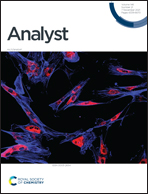Accelerated 13C detection by concentrating the NMR sample in a biphasic solvent system†
Abstract
CDCl3 is the most frequently used solvent for the NMR investigation of organic compounds. Busy chemistry labs need to investigate hundreds of compounds daily. While 1H NMR investigation takes a couple of minutes, recording 13C NMR spectra necessitates hours of signal averaging due to the low abundance and low sensitivity of 13C nuclei. The longer acquisition time for 13C NMR results in a loss of precious spectrometer time in a shared multi-user environment. A regular 5 mm o.d. NMR tube is the most commonly used tube for NMR in organic chemistry labs and is also the cheapest option. We show that for analytes soluble in the CDCl3 solvent using a regular 5 mm o.d. NMR tube, the speed of 13C observation can be enhanced by a factor of two by resorting to a sample preparation method that employs a biphasic system made of H2O or D2O at the top of another layer of CDCl3. By using the biphasic system of two immiscible solvents, the analyte can be concentrated in the CDCl3 layer (within the more sensitive volume of the NMR coil), resulting in the improvement of the signal to noise ratio (SNR) by a factor of up to 1.8 for 13C and 2D 1H–13C HSQC spectra, which results in more than two-fold reduction in the experimental time. 1H NMR and other 2D NMR also get a sensitivity boost. The amount of CDCl3 required for sample preparation can also be reduced by 40% using this biphasic system (CDCl3/H2O). Sample preparation in such an immiscible biphasic system is effortless and straightforward. The performance of such biphasic samples is closer to that of Shigemi tubes and better than that of 3 mm o.d. tubes.



 Please wait while we load your content...
Please wait while we load your content...